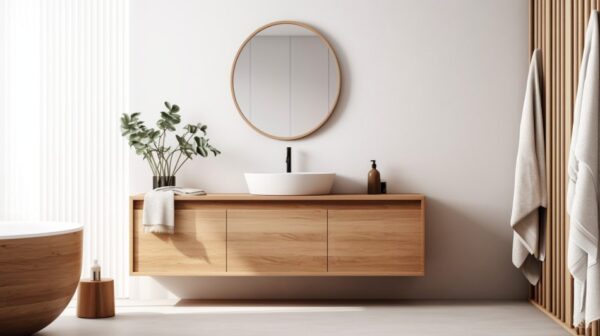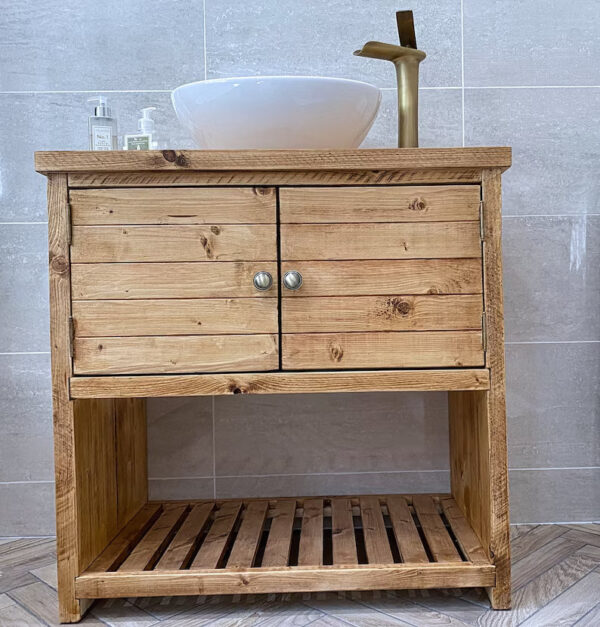If you’re a fan of minimalist design with a touch of warmth and nature, then you’ve probably come across the Japandi style. One of the most crucial elements in a Japandi bathroom is the vanity.
In this article, we’ll explore the characteristics of a japandi bathroom vanity, how to choose the perfect one for your space, and how to integrate it into your bathroom design. So let’s dive in and find our Zen!
Key Features of a Japandi Bathroom Vanity
Japandi design is all about minimalism, natural materials, and functionality. These three features work together to create a stunning and practical focal point in your bathroom.
Minimalist Design
Less is more in Japandi design, and the same applies to the bathroom vanity. Sleek lines, simple shapes, and an overall lack of ornamentation are hallmarks of this style. Your vanity should be uncluttered and visually calming, allowing the natural materials to take centre stage.

Combination of Natural Materials and Textures
A mix of natural materials, such as wood, stone, and metal, is essential for a japandi bathroom vanity. These elements add warmth and an organic touch to the minimalist design, creating a sense of harmony with nature.
Streamlined Functionality
Functionality is key in a bathroom vanity. Make sure your vanity has ample storage for all your bathroom essentials and that it’s easy to keep organized. Drawers and cabinets with built-in dividers and organizers can help keep everything in its place, maintaining the clean and minimalist look of the vanity.

How to Choose the Perfect Japandi Bathroom Vanity
When selecting your bathroom vanity, there are a few factors to consider to ensure it fits seamlessly into your bathroom design.
Assessing Your Bathroom Space and Layout
Before you start shopping, measure your bathroom space and consider the layout. Take note of how you will want to use your bathroom, as well as any obstacles, such as doors or windows, that could impact the placement of your vanity.
It’s a small detail, but if your toilet is next to your vanity, don’t forget to consider how many inches between toilet and vanity you need to ensure comfortable use of both fixtures!
Selecting the Right Size and Style of Vanity
Once you have your measurements, consider which size and style of vanity would work best in your space.
If you have a small bathroom, a single-sink vanity might be the only option. For larger spaces, if you can get away with it, a double vanity might add a bit of luxury to the space.

Keep the Japandi aesthetic in mind when choosing the style of your vanity. Look for simple lines, natural materials, and a minimalist design. A Japanese-style vanity unit with clean lines and a mix of wood and stone materials would be a great choice.
Coordinating with Other Japandi Bathroom Elements
To create a cohesive Japandi bathroom, consider how your vanity will coordinate with the other elements in the space.
This includes lighting, mirrors, and fixtures, as well as any additional Japandi bathroom storage, such as a Japandi bathroom cabinet. Choose complementary materials and finishes to create a harmonious look throughout your bathroom.

Popular Japandi Bathroom Vanity Materials
There are several popular materials used in Japandi bathroom vanities, each with its own unique characteristics and benefits.
Wood
Wood is a classic choice for a Japandi vanity, bringing warmth and a natural feel to the space. Opt for finishes that highlight the wood’s natural grain, such as oak, walnut, or teak. These woods are not only beautiful but also durable and water-resistant, making them ideal for bathroom use.

Stone
Stone countertops, such as granite, quartz, or marble, add an element of luxury and sophistication to a vanity. The natural veining and color variations in the stone create visual interest while maintaining the minimalist aesthetic.

Metal
Metal accents, such as brushed brass or matte black hardware, can add a touch of modernity to your bathroom vanity. These finishes can be used for drawer pulls, faucet fixtures, or even as a stylish frame for your vanity mirror.
Tips for Accessorizing and Organizing Your Vanity
Now that you’ve chosen the perfect Japandi bathroom vanity, it’s time to accessorize and organize. Here are some tips to help you create a serene and functional space.
Use Decorative Trays and Containers
Organize your countertop essentials, such as soap, toothbrushes, and skincare products, in decorative trays or containers that complement your vanity. Look for items made from natural materials, like ceramic, bamboo, or wood, to maintain the cohesive aesthetic.

Incorporate Natural Elements
Bring the outdoors in by adding natural elements to your bathroom decor. Consider placing a small potted plant, such as a bamboo or fern, on your vanity countertop. You can also incorporate natural textures through items like wicker baskets, stone soap dishes, or wooden toothbrush holders.
Keep Clutter to a Minimum
To maintain the minimalist Japandi aesthetic, it’s essential to keep clutter to a minimum. Use your vanity’s storage spaces wisely, and avoid overloading the countertop with too many items. Remember, less is more in Japandi design.
A Japandi bathroom vanity combines the best of minimalist design, natural materials, and functionality to create a tranquil and practical space.
By considering your bathroom’s dimensions, choosing the right materials, and organizing your vanity with care, you can achieve the perfect Japandi oasis in your home.
